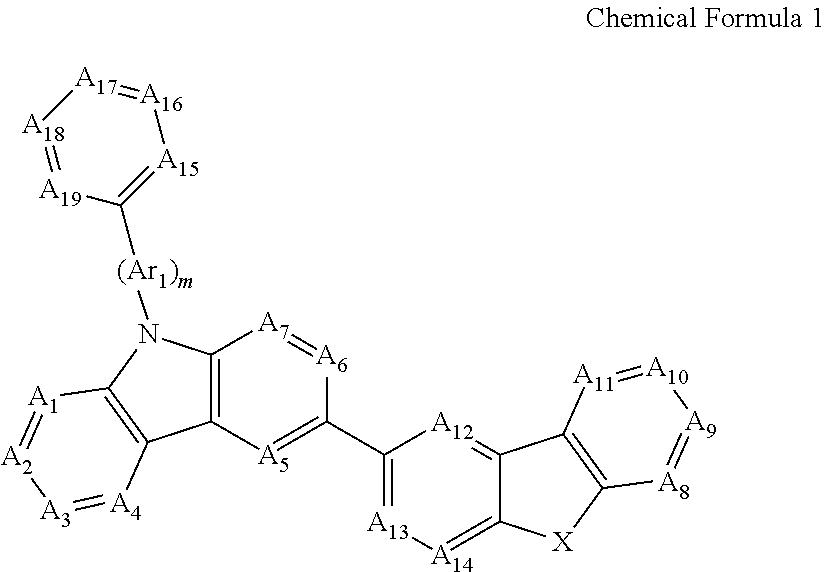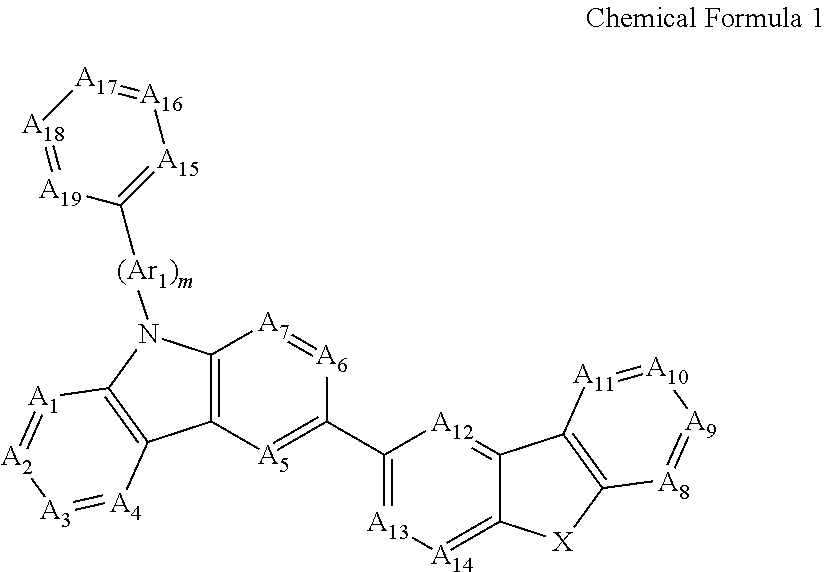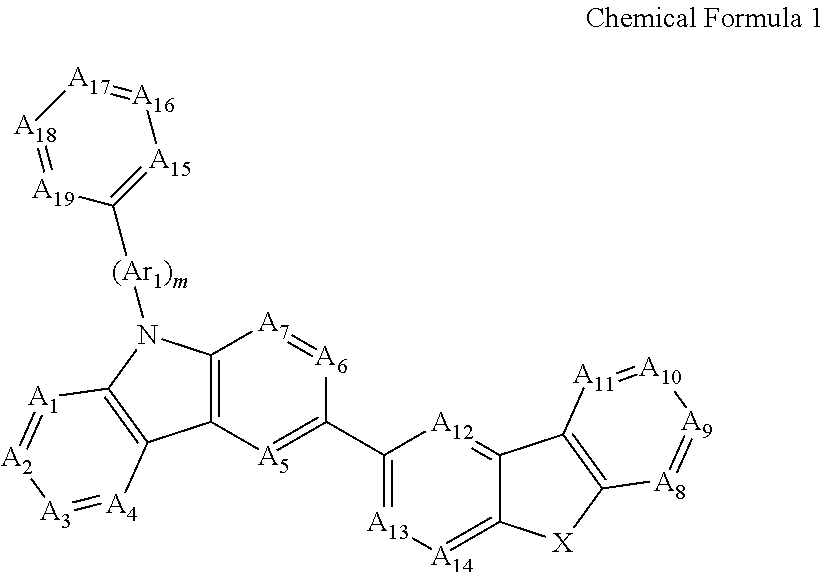Novel organic electroluminescent compounds and organic electroluminescent device using the same
- Summary
- Abstract
- Description
- Claims
- Application Information
AI Technical Summary
Benefits of technology
Problems solved by technology
Method used
Image
Examples
preparation example 1
Preparation of Compound 1
[0054]
[0055]Preparation of Compound 1-1
[0056]9H-carbazole (10 g, 41.10 mmol), 2-chloropyridine (5.60 g, 49.32 mmol), Pd(OAc)2 (0.46 g), NaOt-bu (7.9 g, 82.20 mmol), toluene (100 mL), P(t-bu)3 (2 mL, 4.11 mmol, 50% in toluene) were added and stirred under reflux. 10 hours later, the mixture was cooled to room temperature and distilled water was added. Extracting with EA and drying with MgSO4, drying under reduce pressure was performed. Compound 1-1 (8.3 g, 33.98 mmol, 83%) was obtained via column separation.
[0057]Preparation of Compound 1-2
[0058]1-neck flask was filled with Compound 1-1 (8.3 g, 33.98 mmol), formed a vacuum and was filled with argon. After tetrahydrofuran (500 mL) was added, the mixture was stirred at 0° C. for 10 minutes. NBS (7.35 g, 40.78 mmol) was added thereto and stirred at room temperature for one day. Upon completion of the reaction, the product was extracted with distilled water and EA. After drying an organic layer with MgSO4 and rem...
preparation example 2
Preparation of Compound 49
[0063]
[0064]Preparation of Compound 2-1
[0065]2,4,6-trichloropyrimidine (10 g, 54.51 mmol), phenylboronic acid (16.6 g, 136.29 mmol), Pd(PPh3)4 (3.15 g, 2.72 mmol), 2M K2CO3 (50 mL), toluene (100 mL), and ethanol (30 mL) were added and stirred under reflux. 4 hours later, the mixture was cooled to room temperature and distilled water was added thereto. After extracting with EA and drying with MgSO4, distillation under reduced pressure followed by column separation yielded Compound 2-1 (7 g, 26.24 mmol, 48.14%).
[0066]Preparation of Compound 2-2
[0067]NaH (1.57 g, 39.36 mmol, 60% in mineral oil) was mixed with DMF (70 mL) and Compound 2-1 (7 g, 26.24 mmol) was dissolved in DMF (60 mL). 1 hour later, Compound 9H-carbazole was dissolved in DMF (70 mL). The mixture was stirred for 10 hours. After adding distilled water, extracting with EA, and drying with MgSO4, distillation under reduced pressure followed by column separation yielded Compound 2-2 (7 g, 14.78 mmol...
preparation example 3
Preparation of Compound 51
[0074]
[0075]Preparation of Compound 3-1
[0076]Compound 3-1 (13.2 g, 47.7 mmol, 87.5%) was obtained by combining 2,4,6-trichlorotriazine (10 g, 54.51 mmol) in Preparation Example 2 according to the same method as the preparation of Compound 2-1.
[0077]Preparation of Compound 3-2
[0078]Compound 3-2 (14.5 g, 36.39 mmol, 76.3%) was obtained by combining Compound 3-1 (13.2 g, 47.7 mmol) in Preparation Example 2 according to the same method as the preparation of Compound 2-2.
[0079]Preparation of Compound 3-3
[0080]Compound 3-3 (14.6 g, 30.59 mmol, 84%) was obtained by combining Compound 3-2 (14.5 g, 36.39 mmol) in Preparation Example 2 according to the same method as the preparation of Compound 2-3.
[0081]Preparation of Compound 3-4
[0082]Compound 3-4 (7.2 g, 16.28 mmol, 53.2%) was obtained by combining Compound 3-3 (14.6 g, 30.59 mmol) in Preparation Example 2 according to the same method as the preparation of Compound 2-4.
[0083]Preparation of Compound 51
[0084]Compoun...
PUM
 Login to View More
Login to View More Abstract
Description
Claims
Application Information
 Login to View More
Login to View More - R&D
- Intellectual Property
- Life Sciences
- Materials
- Tech Scout
- Unparalleled Data Quality
- Higher Quality Content
- 60% Fewer Hallucinations
Browse by: Latest US Patents, China's latest patents, Technical Efficacy Thesaurus, Application Domain, Technology Topic, Popular Technical Reports.
© 2025 PatSnap. All rights reserved.Legal|Privacy policy|Modern Slavery Act Transparency Statement|Sitemap|About US| Contact US: help@patsnap.com



